- Popular Fintech
- Posts
- How Mercado Libre built a Fintech empire
How Mercado Libre built a Fintech empire
From solving checkout to rewriting financial services in Latin America
Hey!
I went down the rabbit hole of researching commerce platforms with Fintech arms, and Mercado Libre might be the most impressive example out there. What started as the Amazon of Latin America has quietly morphed into one of the region’s leading Fintech companies, now aiming to build the largest digital bank in Latin America.
The company’s Fintech arm, Mercado Pago, was born out of necessity to facilitate payments on its marketplace. But from there, it grew naturally into a full-stack financial platform. Along the way, it built the Latin American equivalents of PayPal, Square, and Affirm, and now it’s putting the pieces together to become a full-service bank.
If there’s any company that can challenge Mercado Libre, it’s Nubank. Nubank had a head start in lending and already pulled ahead in users and revenue. But with Mercado Pago now scaling aggressively, the real battle will play out in Mexico. Wall Street thinks both companies can thrive, and I think it’s going to be a hell of a fight.
But who doesn’t like a rivalry between two amazing companies?
Let’s dive in!
Jevgenijs
p.s. if you have feedback, just reply to this email or ping me on X/Twitter
I’ve been planning to write about Mercado Libre $MELI ( ▲ 2.49% ) for a while, and I even had a draft back in 2022 that I never published. But now that the company is aiming to become the largest digital bank in Latin America, it’s impossible to ignore. You can expect me to write more often about Mercado Libre in the future, but today, let’s start with the basics.
“We are building the largest digital bank in Latin America. In a region that still faces challenges in accessing quality services, we want to change the way users interact with the financial system with a digital bank where everyone wins.”
Mercado Libre, often called the Amazon of LatAm, is Latin America's leading e-commerce and Fintech platform offering online marketplaces, digital payments, and logistics solutions. The company was founded in 1999 by Marcos Galperin while he was still a student at Stanford.

“Mercado Libre's e-commerce platform is present in 18 countries (Argentina, Brazil, Mexico, Chile, Colombia, Peru, Uruguay, Venezuela, Bolivia, Costa Rica, Dominican Republic, Ecuador, Guatemala, Honduras, Nicaragua, Panama, Paraguay and El Salvador).”
In 2024, Mercado Libre celebrated its 25th anniversary since founding, but Latin America still lags the U.S., the U.K., and China in e-commerce penetration (share of retail sales taking place online). Mercado Libre is not just benefiting from the rise of e-commerce, it’s also consistently expanding its share of the market.

Image source: EMARKETER
“Our e-commerce platform provides buyers and sellers with a robust and safe environment that fosters the development of a large e-commerce community in Latin America, a region with a population of over 650 million people where penetration of e-commerce over total retail significantly lags benchmarks such as the U.S., the U.K. and China.”
Thus, in 2024, over 100 million people shopped on Mercado Libre, up from 44 million in 2019. Like many e-commerce companies, Mercado Libre got a boost from the pandemic-driven shift to online shopping. But unlike most, it kept growing long after the world reopened.

It’s worth noting that the vast majority of sales on Mercado Libre happen between third-party buyers and sellers. The company itself handles less than 10% of gross merchandise volume as a direct retailer. Mercado Libre steps in as a direct seller in select categories where supply is limited or competition is weak.

Data source: Mercado Libre
“The Mercado Libre Marketplace is a user-friendly online commerce platform that can be accessed through our mobile app or website. Third-party sellers ("3P") account for most of the GMV transacted on the Marketplace. We complement this by selling directly to consumers on a first-party basis ("1P") in selected categories where we can enhance price competitiveness and assortment; this accounts for less than 10% of GMV.”
Succeeding in e-commerce required building a logistics business. Thus, in 2024, 94% of the items sold on the Mercado Libre marketplace were delivered through the company’s network of fulfillment centers. Per the company’s annual report, Mercado Libre now owns and leases 4.3 million square meters (46 million square feet) of facilities across Latin America.

Image source: Mercado Libre
There’s more to Mercado Libre’s e-commerce story, like its growing advertising business, but I won’t pretend to be an expert in that. What really caught my attention is the company’s Fintech arm, Mercado Pago. Mercado Pago serves both consumers and merchants, offering everything from digital accounts to POS terminals and lending.

Image source: Mercado Libre
“Aside from communicating the win-win value proposition of MercadoPago, we also want it to be even more closely tied to MercadoLibre at the center of our ecosystem. This is why MercadoPago has turned yellow and now shares the primary color of our ecosystem. We don't want to have a yellow side of the ecosystem and a blue side of the ecosystem. We want to have a single ecosystem.”
Mercado Pago is one of the largest Fintech companies in the region, serving 64 million monthly unique customers. It claims to be the largest Fintech player by monthly active users in Argentina, Mexico, and Chile, and the second largest in Brazil, just behind Nubank.

“…our fintech platform, Mercado Pago, is present in 8 countries (Argentina, Brazil, Mexico, Chile, Colombia, Peru, Uruguay and Ecuador).”
Mercado Pago is also a crucial revenue driver. Thus, the company reports its revenue split between two segments, Commerce and Fintech, and in 2024, Fintech services contributed 41% of the company’s total revenue.

“Our Commerce business is comprised of two primary revenue streams: Services and Product Sales. Our Services revenue stream is mainly generated from Marketplace fees, related shipping fees, classifieds fees, advertising sales fees, and fees from other ancillary businesses. Our Product Sales revenue stream entails selling merchandise on a first-party basis from our own inventory and related shipping fees.”
Mercado Libre’s total revenue increased 8x from $2.3 billion in 2019 to $20.8 billion in 2024. Interestingly, the Commerce and Fintech segments grew at a similar rate. Commerce segment revenue increased from $1.35 billion to $12.16 billion (an 8x increase), while Fintech revenue increased from $0.95 billion to $8.62 billion (also an 8x increase).

Data source: Mercado Libre
“Our Fintech business is comprised of three primary revenue streams: (a) Financial services and income, which includes commissions we charge for transactions off-platform derived from use of the payment solution and asset management product, interest earned on cash and investments as part of Mercado Pago activities, as well as Mercado Pago debit card commissions, and insurtech fees; (b) Credit Revenues, which includes interest earned on loans and advances granted to merchants and consumers, and interest and commissions earned on Mercado Pago credit card transactions; and (c) Fintech Product Sales, which includes revenues from sales of mobile point of sales devices.”
Mercado Libre operates its Commerce platform in 18 countries and its Fintech platform in 8, but most of the revenue still comes from just three, Brazil, Mexico, and Argentina. In 2024, those markets accounted for 95% of Commerce revenue and 97% of Fintech revenue.
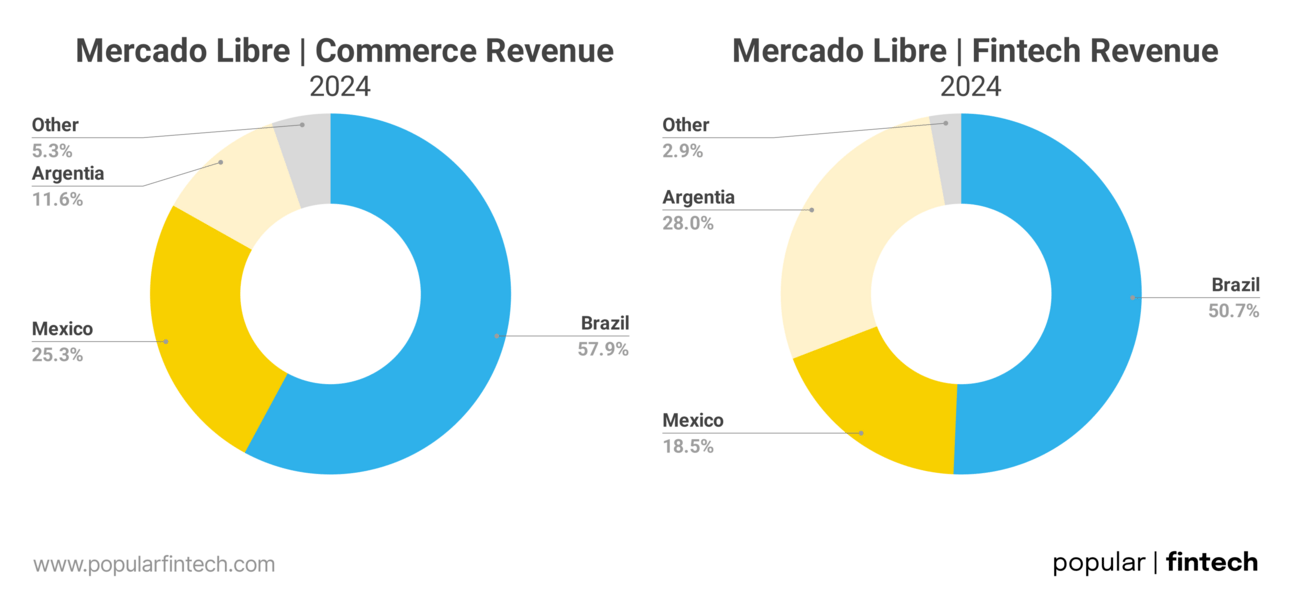
Finally, within the Fintech segment, credit is the key growth engine. Credit revenues increased from $246 million in 2020 to $3.6 billion in 2024 (a 14x increase). Over that time, credit went from making up 17% of Fintech revenue to 41%.
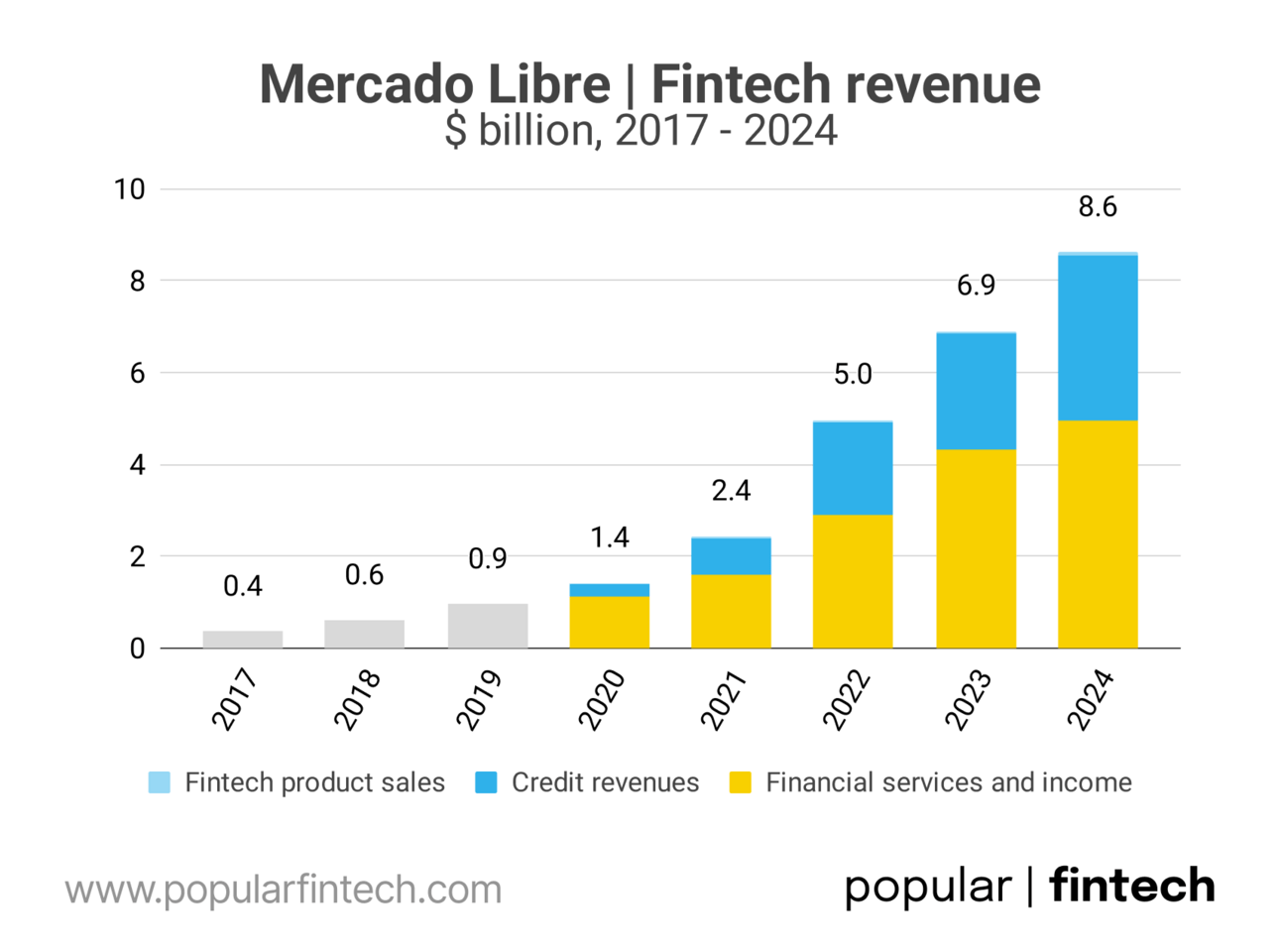
Mercado Pago’s Fintech services can be grouped into three categories: 1) digital banking (not sure why they call it Digital account), b) acquiring business, and c) consumer and merchant lending. As I will argue below, all three of Mercado Libre’s Fintech businesses emerged naturally from its commerce platform, to the point where it begs the question: “Why didn’t Amazon do the same?!”
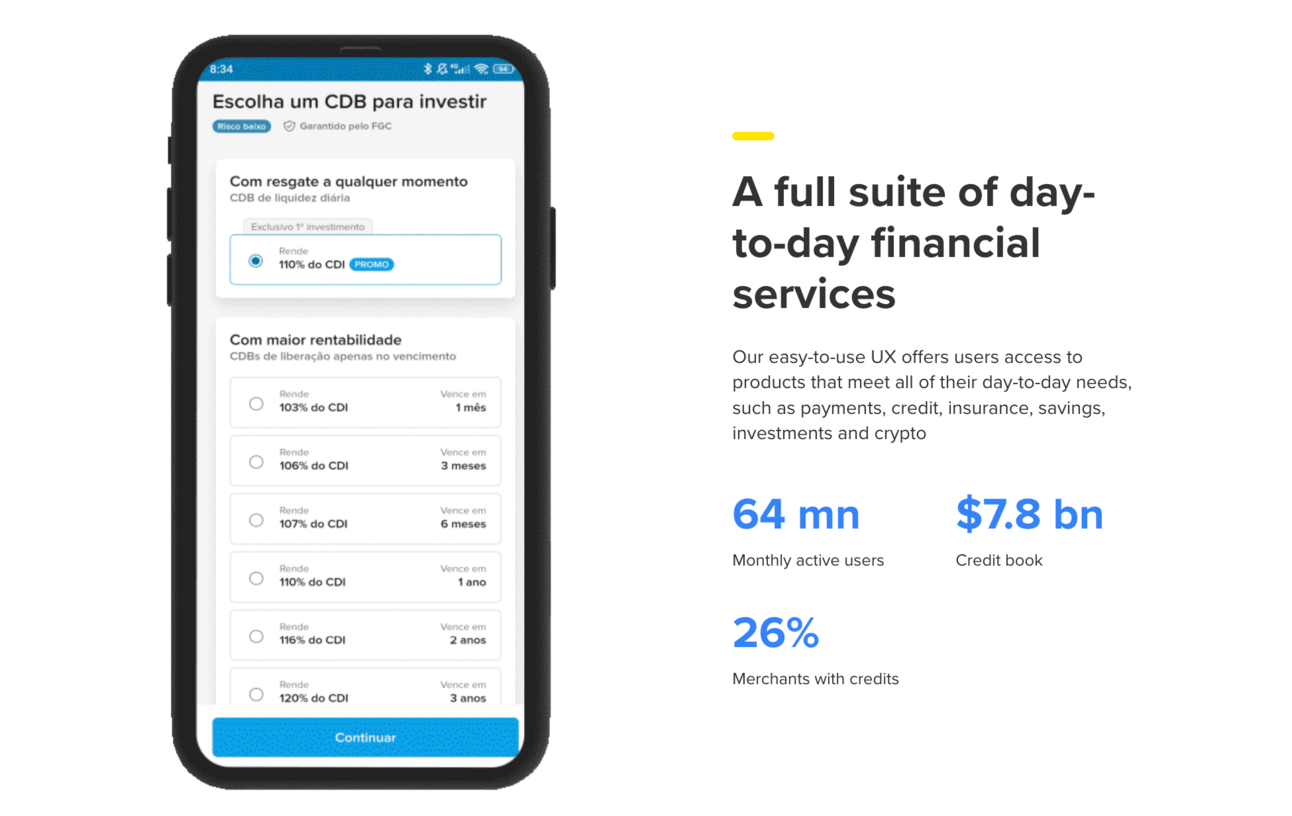
Image source: Mercado Libre
“Mercado Pago was initially designed to facilitate transactions on Mercado Libre’s Marketplace by providing a mechanism that allowed our users to securely, easily and promptly send and receive payments.”
Mercado Pago was originally a wallet that helped buyers and sellers on the Mercado Libre platform transact. Mercado Pago essentially had to (or wanted to) create its own version of PayPal. Mercado Pago launched in 2003, not long after PayPal was acquired by eBay in 2002.

Image source: Mercado Libre
However, there was a fundamental difference between Mercado Pago and PayPal. Credit card penetration in Latin America was low, many people were unbanked, and cash dominated commerce. So while PayPal stayed an online wallet, Mercado Pago became the gateway to digital payments for tens of millions of people.

Image source: Worldpay Global Payments Report 2025
Around 2018–2019, Mercado Pago expanded beyond online payments, transforming its wallet into a full digital account. It then added peer-to-peer transfers, bill payments, debit cards, savings, investments, and insurance, essentially becoming a digital bank for its customers, including consumers and merchants.

“Mercado Pago also offers an array of day-to-day financial services for consumers and merchants through our digital account. The digital account initially offered transfers and simple payments, but today the services offered are much broader.”
Around 2014-2015, the Mercado Pago team realized they were already serving millions of merchants on their commerce platform, many of whom were also selling offline. So, the company launched an acquiring business for SMBs, offering online payment acceptance and POS terminals. Low credit card penetration also meant few POS terminals, so the opportunity was wide open.

Image source: Mercado Libre
“We also observed that individuals and micro, small and medium- sized enterprises (“MSMEs”) in the physical world were being underserved or overlooked by incumbent payment providers and financial institutions in Latin America. Consequently, we deepened our fintech offering by launching payments processing services for offline merchants through the sale of point-of-sale ("POS") devices and quick response ("QR") codes.”
Mercado Pago essentially built Latin America’s version of Square, launching its service across the region just as Square went public. But Mercado Pago had a key advantage: it didn’t need to find merchants, they were already selling on Mercado Libre’s commerce platform.

Image source: Mercado Libre
In 2024, Square processed $227 billion, and Mercado Pago processed $142 billion (of which $88 billion outside of Mercado Libre’s commerce platform). Mercado Pago is now in a phase similar to where Square was a few years ago, building more software for its merchants and pushing to expand upmarket.

Data source: Mercado Libre
“Mercado Pago is the largest fintech acquirer in Latin America by TPV. Our market share is low, and we see huge opportunities to attract and retain new merchants. We are well-positioned to differentiate our payments processing services by leveraging our ecosystem to offer loans and software solutions that help merchants manage their businesses.”
Finally, Mercado Pago started offering credit, first to its merchants (2017-2018) and later to consumers (2019-2020). The company’s loan portfolio increased 30x over the last five years, from $0.21 billion in 2019 to $6.57 billion in 2024. As you can see from the chart below, the main driver of this growth was consumer lending (personal loans and credit cards). Mercado Pago essentially built its own Affirm.
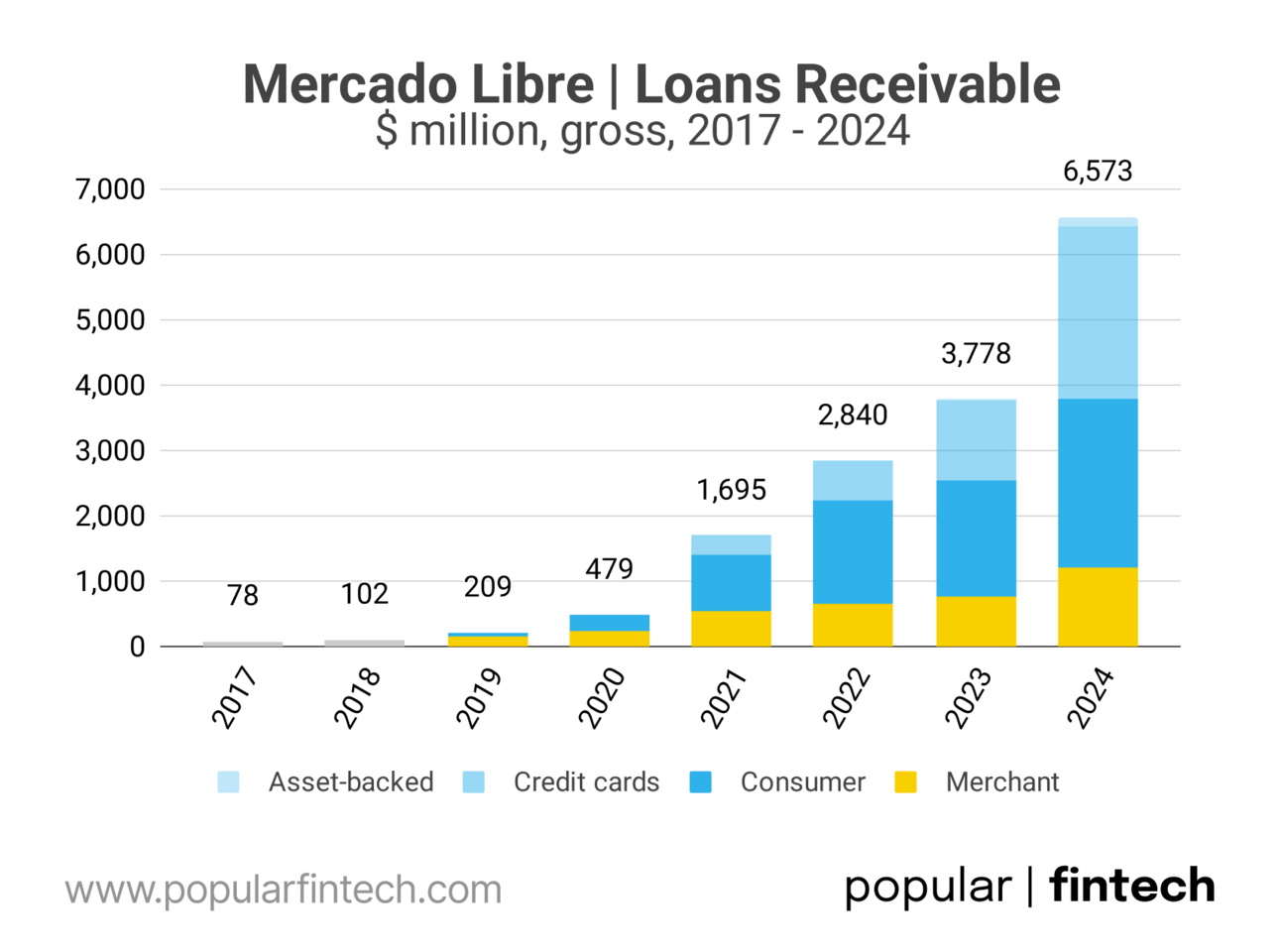
Data source: Mercado Libre
“Our lending solution is available in Argentina, Brazil, Mexico and Chile. We offer credits mostly to merchants and consumers that already form part of our user base, many of whom have historically been underserved or overlooked by financial institutions and therefore suffer from a lack of access to credit.”
What surprised me was that Mercado Pago didn’t launch credit cards until 2021. The company first launched credit cards in Brazil, and two years later in Mexico. Launching credit cards seemed like the obvious next step, especially with Nubank proving just how big that opportunity could be.

Image source: Mercado Libre
“In 2021, we launched the Mercado Pago credit card in Brazil, and this was followed by Mexico in 2023. It is free, internationally accepted, digitally managed and can be used on- and off-platform.”
Speaking of Nubank $NU ( ▲ 0.74% ) …Mercado Pago calls itself “a leading Fintech platform in the region”, not the leading one, because, well…Nubank. Nubank overtook Mercado Pago in monthly active users back in 2020, and the gap has only grown since. By the end of 2024, Nubank was serving 95 million monthly active users, compared to 61 million for Mercado Pago.

“The financial services market is also becoming increasingly competitive with the growth of several fintech companies established in Latin America. Mercado Pago competes in the rapidly evolving fintech space with local and strong global players that offer digital financial services such as access to credit, virtual and physical cards, insurance, savings accounts, and asset management.”
In 2023, Nubank also overtook Mercado Pago in revenue. In 2024, Nubank reported $11.5 billion in revenue, while Mercado Pago reported $8.6 billion (“Fintech revenue”). It should also be noted that almost a third of Mercado Pago’s revenue comes from Argentina, where Nubank is not even present.
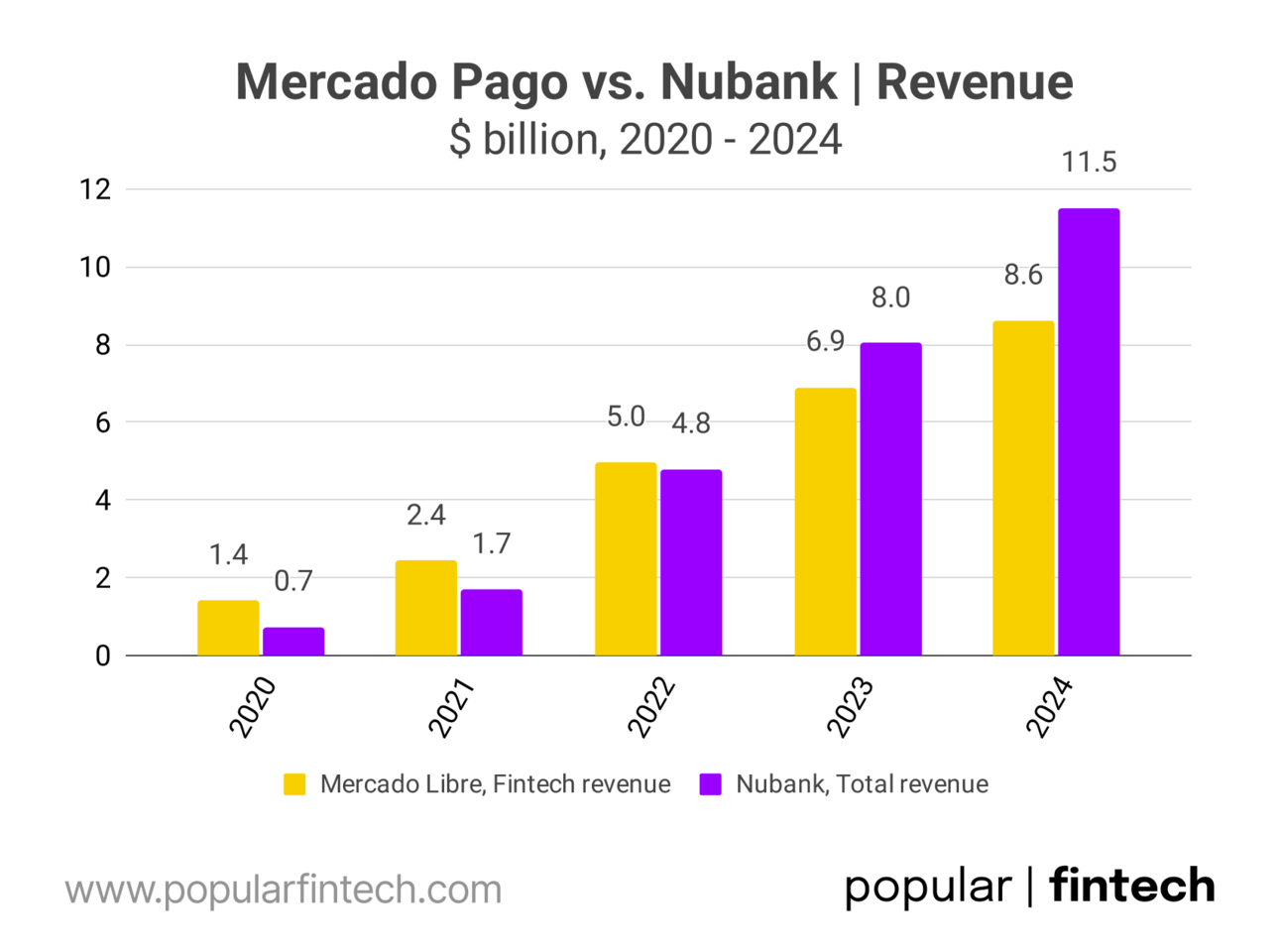
At first glance, it looks like Nubank is crushing Mercado Pago, but that’s likely just the result of a head start. Nubank had a first-mover advantage in lending and is years ahead, especially when it comes to credit cards. With Mercado Pago now aggressively scaling its lending business, the question is: can it close the gap with Nubank?

…and probably a bigger question is: who will win in Mexico? Mexico is a decade behind Brazil in credit card and banking penetration, which means the opportunity is still wide open. Nubank and Mercado Pago have learned their lessons elsewhere and are now bringing that experience to Mexico. Nubank already has a banking license, and Mercado Pago is still waiting on theirs.

Data source: Mercado Libre
“Financial inclusion in Mexico is more than a decade behind Brazil, with just half of the population having a bank account and less than a fifth having a credit card. In Brazil, there is still more disruption to take place, with four incumbent banks accounting for 59% of credit operations and approximately $200bn parked in low-yielding "poupança" accounts.”
At least Wall Street analysts covering Mercado Libre are not worried about the competition with Nubank. They do expect revenue growth to slow gradually, but still forecast Mercado Libre doubling its revenue over the next three years. The forecast covers the whole company, but given Fintech’s share of revenue, that kind of growth will need strong contributions from both segments.

Data source: Mercado Libre, Koyfin
Analysts also expect Mercado Libre to continue improving its efficiency, increasing EBIT margins…

Data source: Mercado Libre, Koyfin
…which will result in 30%+ EPS growth in the coming three years. The same analysts project a similar EPS growth rate for Nubank.

Data source: Mercado Libre, Koyfin
So, it looks like Wall Street expects Mercado Libre and Nubank to co-exist and successfully grow market share, at least in the coming years. I guess this doesn’t mean anything good for the incumbent banks in the region, but who cares?
Cover image source: Mercado Libre
Disclaimer: The views expressed here are my own and do not represent the views of my employer. The information contained in this newsletter is intended for educational and informational purposes only and should not be considered financial advice. You should do your own research or seek professional advice before making any investment decisions. Read the full disclaimer here.
Reply